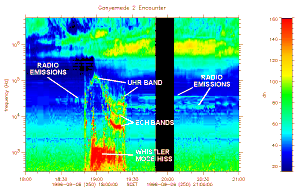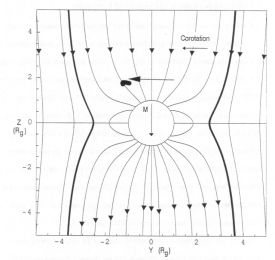Investigation of the Magnetosphere of Ganymede with Galileo's Energetic Particle Detector
Ph.D. dissertation by Shawn M. Stone, University of Kansas,
1999.
Copyright 1999 by Shawn M. Stone. Used with permission.
1.4 The Magnetosphere of Ganymede
As was discussed in Section 1.1, magnetospheres result from the interaction between an incident plasma and a body possessing an intrinsic magnetic field. Ganymede must then possess some sort of magnetosphere given that it has its own magnetic field and the corotational plasma is incident on it. To deduce the nature of such an interaction it is useful to derive the sonic Mach number and the Alfven Mach numbers as was done for the Earth in Section 1.1.1. Uo is the relative velocity of the plasma to the moon, Bo is the ambient magnetic field strength, ρo is the mass density, and po is the combined electron and ion plasma pressure. The values of each of these quantities are quoted or derived by Neubauer [1998] and yield MS=2.4 and MA=.5. This means that the plasma flow is supersonic but sub-Alfvenic. So there is low probability of a bow shock, but the presence of a magnetopause and tail current is not ruled out.
There is much evidence that Ganymede does indeed have its own magnetosphere. The existence of the magnetopause is consistent with the observed magnetic field data marked by a sudden change in orientation of the magnetic field vector seen in Figures 1.14 through 1.17. The Plasma Wave Subsystem (PWS) experiment [Gurnett et al., 1992] observed electromagnetic wave modes that are fingerprints of a magnetosphere, namely whistler-mode emissions, upper hybrid waves, electrostatic electron cyclotron waves and escaping radio emission [Gurnett et al., 1996]. Figures 1.18 and 1.19 show frequency-time spectrograms of the intensity of the electric field component of the wave spectrum. It can be clearly seen that the regions of high wave intensity are encapsulated in the same region defined by the abrupt magnetic field rotations; their boundaries coincide with that of the magnetometer data. Also, for G1 broad band noise bursts are seen on the inbound crossing from 06:14 to 06:20 UT and on the outbound from 06:58 to 07:02 UT. Broadband electrostatic noise bursts of this type are commonly observed at magnetopause boundaries [Gurnett et al., 1979]. The magnetic field geometry with Galileo's trajectory for the G2 and G7 encounter is shown in Figures 1.20 through 1.23. The magnetosphere of this simple superposition model shows a separatrix that separates lines connecting to Jupiter exclusively from those connecting to Ganymede and Jupiter, and closed Ganymede field lines. These lines connecting exclusively to Ganymede out to 2 Rg define this simplified magnetosphere [Kivelson et al., 1998]. Table 1.4 shows the time of the magnetopause crossings for the magnetometer data [Kivelson et al., 1998] and the time of closest approach for the G2 and G7 encounters. The G8 encounter is excluded at the present time from this work.
 |
Figure 1.18 Frequency-time spectrogram of the plasma and radio wave observations of the G1 encounter. The evidence for the magnetosphere of Ganymede is evident in the intense band of electrostatic waves at the upper hybrid frequency which begin and end at the magnetopause boundaries [Kurth et al., 1997]. |
 |
Figure 1.19 Frequency-time spectrogram of the plasma and radio wave observations of the G2 encounter. The G2 encounter shows a similar structure as G1. |
 |
Figure 1.20 ZX projection of the vacuum superposition model for G2 [Kivelson et al., 1996]. The coordinates are in GSII, and hence the corotation direction is in the -y (out of the page). The thick field lines denote the separatrix from Jupiter-Jupiter field lines and Jupiter-Ganymede (Ganymede-Ganymede) field lines. The trajectory of Galileo is shown with points in 5-minute intervals, the first starting at 18:40:00 UT. |
 |
Figure 1.21 ZY projection of the vacuum superposition of a uniform external magnetic field from a model of Jupiter's magnetic field [Khurana, 1997] and the internal magnetic field model of a dipole with 750 nT equatorial surface strength tilted 10° inward from the -z towards Jupiter [Kivelson et al., 1996]. The coordinates are in GSII, and hence the corotation direction is in the -y. The thick field lines denote the separatrix from Jupiter-Jupiter field lines and Jupiter-Ganymede (Ganymede-Ganymede) field lines. The trajectory of Galileo is shown with points in 5-minute intervals, the first starting at 18:40:00 UTC. |
 |
Figure 1.22 ZX projection of the vacuum superposition model for G7 [Kivelson et al., 1996]. The coordinates are in GSII, and hence the corotation direction is in the -y (out of the page). The thick field lines denote the separatrix from Jupiter-Jupiter field lines and Jupiter-Ganymede (Ganymede-Ganymede) field lines. The trajectory of Galileo is shown with points in 5-minute intervals, the first starting at 06:50:00 UT. |
 |
Figure 1.23 ZX projection of the vacuum superposition model of a uniform external magnetic field from a model of Jupiter's magnetic field [Khurana, 1997] and the internal magnetic field model of a dipole with 750 nT equatorial surface strength tilted 10° inward from the -z towards Jupiter [Kivelson et al., 1996] for G7. The coordinates are in GSII, and hence the corotation direction is in the -y. The thick field lines denote the separatrix from Jupiter-Jupiter field lines and Jupiter-Ganymede (Ganymede-Ganymede) field lines. The trajectory of Galileo is shown with points in 5-minute intervals, the first starting at 06:50:00 UT. |
Table 1.4 The magnetopause crossing and closest approach times for the G2 and G7 encounters. Times are in UT.
| Encounter | Closest Approach | Distance to Ganymede (km) | Magnetopause In | Magnetopause Out |
| G2 | 18:59:34 | 264 | 18:50:00 | 19:23:00 |
| G7 | 07:09:58 | 3095 | 07:00:00 | 07:37:00 |
Next: 1.5 Charged Particles in the Vicinity of Ganymede
Return to dissertation table of contents page.
Return to main
Galileo Table of Contents Page.
Return to Fundamental
Technologies Home Page.
Updated 8/23/19, Cameron Crane
QUICK FACTS
Mission Duration: Galileo was planned to have a mission duration of around 8 years, but was kept in operation for 13 years, 11 months, and 3 days, until it was destroyed in a controlled impact with Jupiter on September 21, 2003.
Destination: Galileo's destination was Jupiter and its moons, which it orbitted for 7 years, 9 months, and 13 days.



